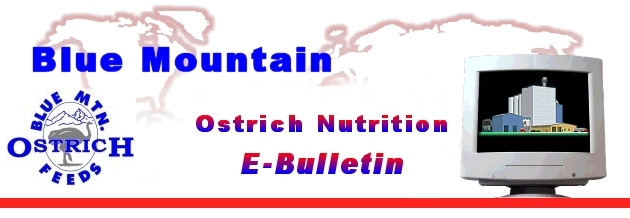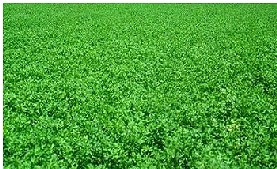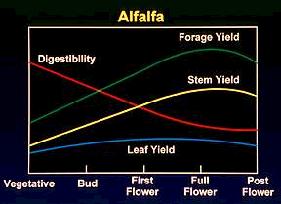

March 5, 2002
Bulletin #77
Table of contents:
Bulletin of the Month
The Importance Of Quality Alfalfa In Ostrich Feed Formulas!
By: Daryl Holle, Blue Mountain Feeds, Inc.
Our e-mail address
Subscribe – Unsubscribe information
Bulletin of the Month
The Importance of Quality Alfalfa in Ostrich Feed Formulas!
Alfalfa, What is it?
Alfalfa is generally known as a most valuable forage crop ideally suited for use in high production livestock feed formulas. It belongs to the Legume family of plants and is of the Genus Medicago. Alfalfa combines the excellent virtues of high dry matter yield and high protein content, minerals (especially calcium), vitamins, and highly digestible Fiber along with good palatability unsurpassed by most other forages.
Alfalfa is also known as Lucerne in many countries throughout the world. Lucerne is the same crop as Alfalfa, just another name that is used. For this writing, we will refer to Alfalfa/Lucerne as Alfalfa.
Figure 1: High Quality Field of Alfalfa

There are many different types and qualities of Alfalfa, the same as most any feed ingredient. The Quality of Alfalfa depends totally on how it is grown in the field and how it is harvested—and WHEN it is harvested.
Quality Alfalfa is raised by crop farmers just like Quality Ostrich is raised by Ostrich farmers. The nutrients in the soil of the Alfalfa field must be correct and have enough nutrient reserves so the Alfalfa plant can thrive and produce a fully nutrient crop. Then, that Alfalfa crop must be properly harvested and stored in order to retain those high quality nutrient levels for use in Ostrich feed formulas. Figure 1 shows a high quality field of Alfalfa and it is easy to see that the Alfalfa plants in this picture are very healthy and full of quality nutrients. An Alfalfa field like this will produce a quality Alfalfa product that will result in a high “productive performance” for Ostrich feed formulas in the most cost effective manner.
Figure 2: Low Quality Field of Alfalfa

Figure 2 shows a very low quality field of Alfalfa. As you can clearly see, the crop in Figure 2 is unhealthy, shows lots of variance is color indicating very poor soil nutrition factors, and the plants are very mature indicated by the purple flowers beginning to bloom. This field is way past the proper harvesting stage for a quality Alfalfa product and will result in a Forage ingredient that is poor quality for Ostrich feed formulas.
There is a lingering thought within the Ostrich Industry that “Alfalfa is Alfalfa” which is so misleading and UNTRUE! The differences between Alfalfa purchased from one farmer can be as different as night and day when purchased from another farmer. Sometimes, even Alfalfa purchased from the SAME farmer can vary greatly as it totally depends on what field the crop came from and when it was harvested. Even some unknowledgeable Nutritionists from feed companies only specify ALFALFA in their Ostrich feed formulations without specifying any type of grade, nutrient content and so on. This mistake by Nutritionists leads to UNPRODUCTIVE feed formulas being mixed and used by many Ostrich farmers and many bird problems result because of that error.
As shown in Figure 3, Alfalfa can vary greatly depending on when it was harvested. The harvest stage has a significant and direct effect on the nutrient content of Alfalfa. Figure 3 also proves that “all Alfalfa is NOT the same” and can have a positive or negative effect on an Ostrich feed formula depending on the QUALITY of the Alfalfa itself.
Figure 3: Nutrient Values vs. Alfafa Maturity

To best demonstrate why it is so important to KNOW the exact quality of Alfalfa being used in an Ostrich feed formula, we can use a couple charts to simply explain that need. Figure 4 is a chart that shows a few nutrient values for a good Ostrich Breeder feed. Please remember that in a good Ostrich Breeder feed, there are nearly 60 important nutrients to be considered, but for simplicity purposes of this discussion, we will only use Protein, Fiber, Calcium and Phosphorus to demonstrate the effects of Alfalfa quality on Ostrich Breeder feed formulas.
Figure 4: Typical Ostrich Breeder Feed Nutrient Values

For purposes of this demonstration, let’s assume for a moment that within the Total Feed Formula, 38% of the total weight of the formula is coming from Alfalfa as the main Forage ingredient and the other 62% of the Total Feed Formula is grains, protein feeds, minerals, vitamins & additives for a complete feed formula. Figure 5 shows the result of using Alfalfa of GOOD quality that carries an average protein content of 20% which indicates it was from a well managed field of Alfalfa and was harvested at the correct stage.
The amount of the individual nutrient contribution by this Alfalfa ingredient to the Total Feed Formula can be calculated by multiplying the “% of Total” column times each of the nutrient values shown for “20% Good Alfalfa” in Figure 1 above (Protein, Fiber, Calcium, Phosphorus). The “Rest of Formula Ingredients” obviously provides the remainder of the nutrients so that the “Total Feed Formula Nutrients” equal Figure 4.
Figure 5: Ostrich Breeder Feed Using 20% Protein Alfalfa

Using Figure 5 table as a reference, we can now see what happens when a farmer, or the people formulating and mixing the Ostrich feed formula, substitutes a LOW QUALITY Alfalfa for the GOOD QUALITY Alfalfa as shown in Figure 6.
Figure 6: Breeder Feed Using 13% Protein Alfalfa

Figure 6 clearly demonstrates that substituting poor Alfalfa for good Alfalfa without reformulating the feed formula makes a significant difference in the Protein, Fiber, Calcium and Phosphorus levels in the total feed. In fact, that simple mistake of substitution of Alfalfa quality brought the total feed formula from a very good productive feed formula in Figure 5 to a non-productive feed formula for Ostrich in Figure 6. The new formula in Figure 6 with the incorrect Alfalfa quality is seriously lacking of Protein, far too much Fiber which will interrupt utilization of other nutrients, and also caused a slight deficiency of Calcium and Phosphorus.
“All Alfalfa is NOT alike”--The Grade and Quality of Alfalfa used in Ostrich rations must always be specified, identified, and KNOWN in order to develop a productive Ostrich feed formula that is properly balanced.
Figure 7: Alfalfa Digestibility & Maturity

Another important factor to consider when discussing Alfalfa quality to be used in Ostrich feed formulas is the Fiber DIGESTIBILITY. Since Alfalfa is providing a major percentage of the digestible fiber in the total formula, it is crucial that this Fiber be as digestible as possible to allow for a good productive performance feed formula.
Figure 7 shows why the stage of harvest is so crucial to good Alfalfa quality and high digestibility. As the Alfalfa plant begins to gradually mature, it forms a bud that will begin to open into a flower. In a short time the flower will fade and a seed pod will form. The entire process from “Bud” stage to “Post Flower” stage is only a matter of a few days. Figure 7 shows how quickly the characteristics of Alfalfa CHANGE during this period of maturity. It is a proven scientific fact that when Alfalfa is in the “Bud” stage, the Fiber Digestibility is HIGH while at the same time the total expected yield of the Alfalfa is rather low and not to its peak. As the Alfalfa matures into the “First Flower” stage and on through the “Full Flower” and “Post Flower” stage, the expected yield increases rapidly along with the Stem Yield while the Leaf Yield remains rather steady throughout the stages of maturity.
To put Figure 7 in Layman’s language, the reason the expected yield is increasing as the Alfalfa matures is the Stems of the plant are getting much larger. The reason the digestibility is going down is because the Stems is the most undigestible part of the Alfalfa plant. The leaves of the Alfalfa plant are highly digestible.
If you study Figure 7 carefully, you will now understand WHY many unknowledgeable farmers raising alfalfa always want to “Go for High Yield” as that means more tonnage per acre for them and more dollars of revenue per acre of Alfalfa. But, going for High Yield always results in poor quality alfalfa with low protein and high undigestibility. That is why there is so much poor quality Alfalfa in the world.
The proper answer to this dilemma is a COMPROMISE! The proper time to harvest Alfalfa for reasonably good quality AND yield is when the Alfalfa field is around “10% flower”. That means when one plant in ten is beginning to open its flower, that field needs to be cut TODAY! That will generate a quality Alfalfa ingredient for use in productive Ostrich feed formulas with a reasonably good protein level and high digestibility—while at the same time provide a reasonable yield for the farmer.
In return for the Alfalfa farmer raising this quality crop, the Livestock feed industry should always be prepared to pay a small premium for this quality Alfalfa based on a verified lab test analysis of the Alfalfa after harvest. In the United States, this reward payment for quality has become quite sophisticated between buyers and sellers with several dollars increased premium per ton of Alfalfa for each percentage of increased Alfalfa protein content over 18% protein. Higher quality Alfalfa containing higher protein, high digestibility factors is very cost effective in Ostrich feed formulas as it reduces the need for extra protein from other feed ingredient sources that is always MOST expensive. Using high quality Alfalfa also makes it possible to develop HIGH PERFORMANCE Ostrich feed formulas which is not possible using low quality Alfalfa.
Summary:
1. If it is possible, check out the Alfalfa fields of the farmer you intend to buy from. View the quality of the Alfalfa field and watch when the farmer harvests that field to assure that the harvest was of quality and that the Alfalfa was of good field quality.
2. Make sure that the Alfalfa field has a minimum amount of weeds and grass growing in the field. Large amounts of weeds and grass will change the nutrient values of the Alfalfa---they also severely affect the fiber digestibility and can cause low protein and calcium contents in the Alfalfa when fed to livestock. If it is Alfalfa you are buying, buy 100% Alfalfa and insist on it as that is what your Ostrich feed formula is requiring for productive feed formulas.
3. Never substitute a low quality Alfalfa for a high quality Alfalfa without first getting the feed formula re-calculated. Never substitute a high quality Alfalfa for a low quality Alfalfa for the same reason.
4. Always know exactly what quality of Alfalfa you are feeding with routine sampling and lab testing to ascertain that quality level. As with any agricultural industry, the Alfalfa industry constantly has some individuals “playing tricks” on the unsuspecting people so never trust a farmer handing you a sheet of paper showing a test analysis that is supposed to be a sampling from the Alfalfa you are buying—TEST IT YOURSELF and buy it accordingly.
5. Never mix poor quality Alfalfa with good quality alfalfa in hopes of attaining an average quality Alfalfa. It doesn’t work that way as part of your Alfalfa mix is still POOR with low fiber digestion factors and low calcium, phosphorus, and other nutrients. Remember, you cannot change a paint color from black to white by added more white—it only gets gray!
6. For productive Ostrich feed formulas, always use the higher quality Alfalfa of a minimum 17% protein content. NEVER use the lower quality Alfalfa of less than 17% protein content as it will not result in a productive Ostrich feed diet for your birds.
 |
Click to return to Contents Page
Contact Information:
If you have any Bulletin Topics you would like us to consider for publication in a future E-Bulletin, e-mail your information to
. We are always interested in hearing your ideas about the value of this E-Bulletin, or whether you have any problems viewing this document.
If you would like to discontinue your subscription to this E-Bulletin, or if you have additional e-mail addresses to add to our subscriber list, please visit the following page on our website and use the automated form to “subscribe” or “unsubscribe”: www.blue-mountain.net/feed/bulletin.htm
Also check out our web site at www.blue-mountain.net for feature articles addressing Ostrich Nutrition, Feeding Management, and Ostrich Farm Management.
Click to return to Contents Page
 |
Blue Mountain Ostrich Nutrition E-Bulletin © March 2002
Return to Bulletin Menu